“‘Pure Religion’: Watchcare and Ministering through Visiting Teaching,” Daughters in My Kingdom: The History and Work of Relief Society (2011), 103–124
“Chapter 7,” Daughters in My Kingdom, 103–124
Chapter 7
“Pure Religion”
Watchcare and Ministering through Visiting Teaching
When Jesus Christ was on the earth, He showed us the way we should live. “He marked the path and led the way,” Sister Eliza R. Snow wrote.1 He showed us how to minister—how to watch over and strengthen one another. His was a ministry to individuals, one by one. He taught that we should leave the ninety and nine to save the straying one.2 He healed and taught individuals, even spending time with each person in a multitude of 2,500 people, allowing each to receive a personal witness of His divinity.3
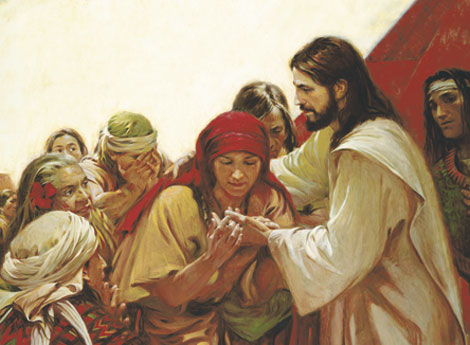
Through His example, the Savior taught us how to watch over and strengthen one another.
Detail from One by One, by Walter Rane. Courtesy Church History Museum.
The Savior calls His disciples to work with Him in His ministry, giving them the opportunity to serve others and become more like Him. In Relief Society, each sister has the opportunity to watch over and strengthen sisters one by one through visiting teaching. Sister Julie B. Beck, the fifteenth Relief Society general president, said, “Because we follow the example and teachings of Jesus Christ, we value this sacred assignment to love, know, serve, understand, teach, and minister in His behalf.”4
Beginnings of Visiting Teaching: Collecting Donations and Organizing Service
“Let us have compassion upon each other, and let the strong tenderly nurse the weak into strength, and let those who can see guide the blind until they can see the way for themselves.”
Brigham Young
Teachings of Presidents of the Church: Brigham Young (1997), 219
In 1843, as the population of Nauvoo, Illinois, expanded, the Latter-day Saints in the city were divided into four wards. In a meeting held on July 28 of that year, Relief Society leaders appointed a visiting committee of four sisters for each ward. The visiting committees’ most visible responsibilities were to assess needs and collect donations.
Donations included money, food, and clothing. Each week, visiting committees gave the donations they had collected to the treasurer of the Relief Society. The Relief Society used these donations to provide aid and relief for the needy.
In fulfilling this responsibility, one sister expressed her belief that “our salvation depend[s] on our liberality to the poor.” Another sister expressed her agreement, saying: “The Lord confirms it again and again. He is delighted with our acts of charity.”5

Visiting committees collected donations to help with local needs.
Pioneer Women, by Julie Rogers. © Julie Rogers.
This practice continued well into the twentieth century. Generally the sisters who were assigned to go visiting went with baskets in hand, receiving items such as matches, rice, baking soda, and bottles of fruit. Most donations were used to help with local needs, but some were used to meet needs thousands of miles away. For example, after World War II, Relief Society sisters in the United States gathered, sorted, mended, and packed more than 500,000 articles of clothing and sent them to Europe.
In addition to collecting donations, visiting committees assessed the needs in the homes they visited. They reported their observations to Relief Society leaders, who organized efforts to help.
President Joseph F. Smith, the sixth President of the Church, told of a time when he saw Relief Society sisters extend unselfish, Christlike love to a family:
“It was my privilege not long ago to visit one of our settlements in an outlying Stake of Zion where a great deal of sickness prevailed at the time, and although we had been traveling many days and we reached the settlement late in the evening, we were solicited to go round with the president to visit some of the sick. We found a poor sister prostrate upon a bed of sickness, in a very critical condition. Her poor husband sat by her bedside almost distracted at the dreadful illness of his wife who was the mother of a number of little children clustered around. The family seemed to be in a very destitute condition.
“A nice matronly woman soon came into the house, carrying with her a basket containing nourishing food and some delicacies for the use of the afflicted family. On inquiry we learned that she had been detailed by the Relief Society of the ward to watch over and administer to the sick woman through the night. She was there prepared to look after the little children, to see that they were properly washed and fed and put to bed; to tidy up the house and make everything as comfortable as possible for the afflicted woman and her family. We also learned that another good sister would be detailed to relieve her the following day; and so on, from day to day, this poor, afflicted family received the kindest care and attention from the sisters of the Relief Society until health should again come to relieve the sick one from her sufferings.
“We also learned that this Relief Society was so organized and disciplined that all the sick in the settlement were receiving similar attention and ministrations for their comfort and relief. Never before had I seen so clearly exemplified the utility and beauty of this grand organization as in the example we here witnessed, and I thought what a gracious thing it was that the Lord inspired the Prophet Joseph Smith to establish such an organization in the Church.”6
Visiting Teaching as a Spiritual Ministry
While visiting teachers have always looked after the temporal needs of individuals and families, they have also had a higher purpose. Sister Eliza R. Snow, the second Relief Society general president, taught: “I consider the office of a teacher a high and holy office. I hope the sisters do not think that it consists merely in begging for the poor. You want to be filled with the Spirit of God, of wisdom, of humility, of love, that in case they have nothing to give they may not dread your coming.”
Sister Snow hoped that sisters would “perceive a difference in their houses” after a visit.7 She counseled visiting teachers to prepare themselves spiritually before they visited homes so they would be able to ascertain and meet spiritual needs as well as temporal ones: “A teacher … should surely have so much of the Spirit of the Lord, as she enters a house to know what spirit she meets in there. … Plead before God and the Holy Ghost to get [the Spirit] so that you will be able to meet that spirit that prevails in that house … and you may feel to talk words of peace and comfort, and if you find a sister feeling cold, take her to your heart as you would a child to your bosom and warm [her] up.”8
Sarah M. Kimball
Sarah M. Kimball, who served as a ward Relief Society president in the late 1860s, shared similar counsel with the sisters in her ward: “It is the duty of teachers to visit their [assigned sisters] once a month, to inquire after the prosperity and happiness of the members. It is their duty to speak words of wisdom, of consolation and peace.”9 Relief Society leaders emphasized that visiting teachers were “not only to gather means but to teach and expound the principles of the gospel.”10 In 1916, visiting teachers were formally asked to discuss a gospel topic each month as well as providing temporal service. In 1923, the general Relief Society presidency introduced uniform monthly messages to be given by all visiting teachers.
“The Rebirth of Visiting Teaching”—“A Beautiful Experience for Women”
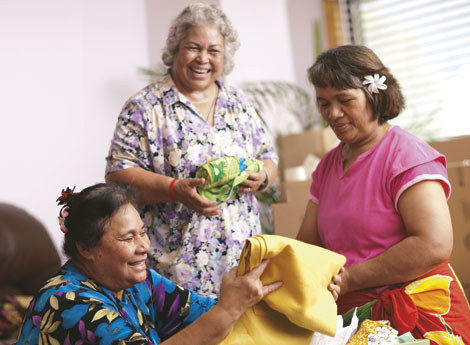
Visiting teachers have always strived to meet the spiritual and temporal needs of those they visit.
In 1944, eight years after the implementation of the Church’s welfare plan (see chapter 5), Sister Amy Brown Lyman, the eighth Relief Society general president, began to question visiting teachers’ traditional responsibility to collect donations. After studying the issue, she and her counselors recommended to the Presiding Bishopric that “the matter of collection of funds … should be decided by the General Authorities of the Church rather than by the Relief Society.”
Presiding Bishop LeGrand Richards took the recommendation to the First Presidency. He later reported that the First Presidency and the Bishopric felt that it was “advisable for the Relief Society to discontinue the collections of charity funds by the visiting teachers.”11
Sister Belle S. Spafford, who was serving as Sister Lyman’s second counselor at the time, shared a personal account of this change in visiting teaching:
“The Brethren said, ‘No more collection of charity funds by the Relief Society visiting teacher. You will become a service organization, not a financing organization of charity relief.’
“… I very well recall sitting one day in a meeting with members of the Relief Society presidency and the secretary and two or three of the board members, when one of the sisters said, ‘They have sounded the death knell of visiting teaching. If they can’t go to collect for the poor, who’s going to want to go from door to door just to visit?’ … I spoke up and I said, ‘I don’t believe it’s the death knell. I believe it’s the rebirth of visiting teaching. And I believe that countless women who have refused to serve as visiting teachers will now be glad to go when they go as friendly visitors to observe conditions in the home where there is need without making a social welfare investigation; when they don’t have to feel like they’re begging for money. They will know they go to build the spirit of the home. And it will be a beautiful experience for women who need it. … I don’t think for one minute that this is the death knell of visiting teaching.’
“It did not prove to be. From then on the program began to flourish and women who had not served before asked to be visiting teachers.”12

Visiting teachers in central Africa traveling to visit their sisters
Sister Spafford later served as the ninth Relief Society general president. She saw countless examples of the good that visiting teaching can bring into the lives of all Relief Society sisters. She testified:
“Some of the very fine work is done by our visiting teachers and our Relief Society presidents, because they go under the spirit of their calling and they are emissaries of Relief Society. … They are mothers, and they have the human understanding of other women and their sorrows. So we must not narrow our concept of the social welfare to the hungry or the poor. The Savior told us to remember the poor in spirit, didn’t he? And don’t the rich get sick, the same as the poor; and don’t they have a hard time to find a nurse? … Now that’s what Relief Society is supposed to be doing. I could tell you story after story after story where visiting teachers have done skilled work in alleviating trouble in a home, simply in the office of their calling.”13
A Privilege, a Duty, and a Commitment: Sharing the Vision of Visiting Teaching Worldwide
President Henry B. Eyring, a counselor in the First Presidency, testified that visiting teaching is part of the Lord’s plan to provide help for people all over the world:
“The only system which could provide succor and comfort across a church so large in a world so varied would be through individual servants near the people in need. The Lord had seen that coming from the beginning of Relief Society.
“He set a pattern in place. Two Relief Society sisters accept their assignment to visit another as a call from the Lord. That was true from the start. …
“The members of Relief Society have always been trusted by local priesthood shepherds. Every bishop and every branch president has a Relief Society president to depend upon. She has visiting teachers, who know the trials and the needs of every sister. She can, through them, know the hearts of individuals and families. She can meet needs and help the bishop in his call to nurture individuals and families.”14
As President Eyring observed, visiting teaching is well suited to the worldwide growth of the Church. Through this system of watchcare, each Latter-day Saint woman has the opportunity to be an instrument in the Lord’s hands.
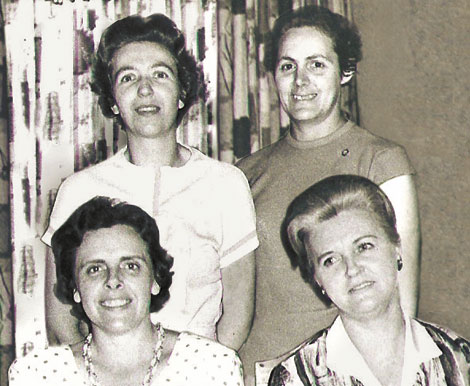
Sister Geraldine Bangerter, bottom left, with Brazilian sisters who helped establish Relief Society in their homeland
Relief Society sisters have worked diligently to establish visiting teaching throughout the world. For example, when the Church was young in Brazil, most branches did not have Relief Societies or knowledge about how to establish them. Because local leaders were unfamiliar with Relief Society, William Grant Bangerter, the mission president at the time, called his wife, Geraldine Bangerter, to be the mission Relief Society president. She was unfamiliar with the country, she had not yet gained proficiency with the language, and she had just given birth to their seventh child. Nevertheless, she started working with counselors and a secretary. With help from sister missionaries who acted as interpreters, these sisters decided that “the first thing they needed to do was teach the women how to visit each other and learn about their needs. So they said, ‘We’re going to teach about visiting teaching.’ …
“They decided to start with a little branch [in] São Paulo in the industrial part of the city, whose inhabitants were mainly poor. The presidency sent word ahead to the few sisters of that branch, saying, ‘Please meet us on this night at this time in the building that we rent.’”
Sister Bangerter and one of her counselors “drove across a city of twelve million people. They showed up at the branch, where … there were seven humble women.”
After the sisters began the meeting with a song and a prayer, one of Sister Bangerter’s counselors stood to teach about visiting teaching. “She held a little paper; she trembled so much it was shaking. She got up and read her message. It lasted five minutes.
“She sat down, and they all turned to look at [Sister Bangerter], who said, ‘I don’t speak Portuguese.’ But they wanted her to be their teacher. No one in the room spoke English. She stood up and said all the Portuguese she knew. It came out as a four-sentence paragraph:
“‘Eu sei que Deus vive.’ I know that God lives.
“‘Eu sei que Jesus é o Cristo.’ I know that Jesus is the Christ.
“‘Eu sei que esta é a igreja verdadeira.’ I know this is the true church.
“‘Em nome de Jesus Cristo, amém.’ In the name of Jesus Christ, amen.
“That was the first Relief Society meeting held in that branch—a five-minute talk on visiting teaching from a sister who’d never had a visiting teacher, seen a visiting teacher, or been a visiting teacher, [followed by] a testimony of the gospel.
“… Out of that little group and others like them has grown a wonderful, vibrant, faith-filled body of women in the country of Brazil. They’re talented, educated, intelligent, fabulous leaders, and they would never be what they are without the gospel of Jesus Christ and their faith.”15
Visiting teaching has become a vehicle for Latter-day Saint women worldwide to love, nurture, and serve—to “act according to those sympathies which God has planted in your bosoms,” as Joseph Smith taught.16
Dedicated visiting teachers answer the call from latter-day prophets to give Christlike service. President Spencer W. Kimball, the twelfth President of the Church, taught: “God does notice us, and he watches over us. But it is usually through another person that he meets our needs. Therefore, it is vital that we serve each other in the kingdom.”17 President Thomas S. Monson, the sixteenth President of the Church, said: “We are surrounded by those in need of our attention, our encouragement, our support, our comfort, our kindness. … We are the Lord’s hands here upon the earth, with the mandate to serve and to lift His children. He is dependent upon each of us.”18
Visiting Teaching Today: A Continuing Effort to Follow Jesus Christ
The story of visiting teaching continues in the lives of sisters everywhere, as Latter-day Saint women fulfill their covenant to follow Jesus Christ. President Dieter F. Uchtdorf, a counselor in the First Presidency, said: “You wonderful sisters render compassionate service to others for reasons that supersede desires for personal benefits. In this you emulate the Savior, who, though a king, did not seek position, nor was He concerned about whether others noticed Him. He did not bother to compete with others. His thoughts were always tuned to help others. He taught, healed, conversed [with], and listened to others. He knew that greatness had little to do with outward signs of prosperity or position. He taught and lived by this doctrine: ‘He that is greatest among you shall be your servant.’”19
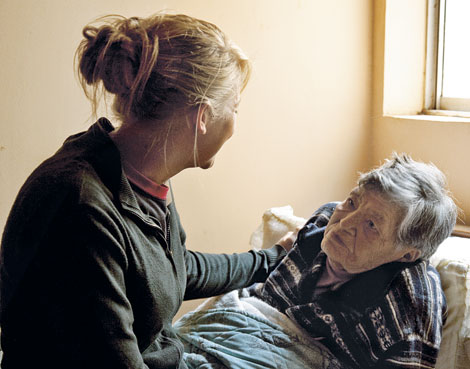
In rendering compassionate service, Relief Society sisters follow the example of Jesus Christ.
Through the years, sisters have learned that visiting teaching requires commitment, dedication, and sacrifice. They have learned that they need the Spirit to direct their visits. They have seen the power that comes through teaching truth and bearing testimony, giving temporal help with love, and being willing to mourn with, comfort, and help bear the burdens of their sisters.
Commitment, Dedication, and Sacrifice
“Who, even in the wildest stretch of imagination, can fathom the uncountable acts of charity that have been performed, the food that has been put on barren tables, the faith that has been nurtured in desperate hours of illness, the wounds that have been bound up, the pains that have been ameliorated by loving hands and quiet and reassuring words, the comfort that has been extended in times of death and consequent loneliness?”
Gordon B. Hinckley
Ensign, Mar. 1992, 4
President Kimball emphasized that visiting teachers need complete commitment and dedication. He said: “Your duties in many ways must be much like those of the [home] teachers, which briefly are ‘to watch over the church always’—not twenty minutes a month but always—‘and be with and strengthen them’—not a knock at the door, but to be with them, and lift them, and strengthen them, and empower them, and fortify them—’and see that there is no iniquity, … neither hardness, … backbiting, nor evil speaking.’”20 President Kimball saw such dedication in his wife, Camilla, who said the following about her efforts as a visiting teacher: “I have tried not to suppress any inclination to generous word or deed.”21
Visiting teaching is an ongoing assignment; it is never really completed. Visiting teachers often are required to sacrifice and rise above discouragement. This is especially true when their efforts seem to be going nowhere, as in the story of Cathie Humphrey:
“When I was first called to be a visiting teacher, I was assigned a young woman who never came to church. … I faithfully went every month and knocked on her door. She would open the inside door but leave the screen door shut. … She would not say anything. She would just stand there. I would look cheerful and say, ‘Hi, I’m Cathie, your visiting teacher.’ And as she would say nothing, I would say, ‘Well, our lesson today is on …’ and try briefly to say something uplifting and friendly. When I was through, she would say, ‘Thank you,’ and shut the door.
“I did not like going there. … But I went because I wanted to be obedient. After about seven or eight months of this, I got a phone call from the bishop.
“‘Cathie,’ he said, ‘the young woman you visit teach just had a baby who lived only a few days. She and her husband are going to have a graveside service, and she asked me to see if you would come and be there with her. She said you are her only friend.’ I went to the cemetery. The young woman, her husband, the bishop, and I were at the graveside. That was all.
“I had seen her only once a month for a few minutes at a time. I hadn’t even been able to tell through the screen door that she was expecting a baby, yet even my inept but hopeful visiting had blessed us both.”22
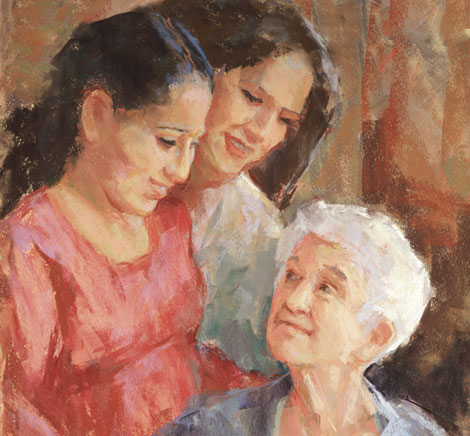
Visiting teachers and those they serve can strengthen and uplift one another.
Detail from The Influence of Righteous Women, by Julie Rogers. © 2009 Julie Rogers.
Seeking Spiritual Guidance
Time after time, faithful visiting teachers have sought and received spiritual guidance. A Relief Society sister in Brazil told of a time when she received the Lord’s help:
“I have no way to reach the sisters by phone. We don’t have telephones. So I go to my knees in prayer to find out the sisters that need me that week. It never fails. [For instance], we had a dear young woman in our ward that had no clothes for her new baby. I had no idea when she was due but I knew she was close. I got a group of sisters together and we made some clothes for her baby. We didn’t want her to bring that baby home in newspapers. We could not telephone one another and so I prayed and I was told when I should go to the hospital with this layette [baby clothes]. When I arrived at the hospital she had just given birth to her baby and I was able to present the clothes to her that were from her Relief Society sisters.”23
Since each sister’s circumstances are different, visiting teachers need specific guidance from the Holy Ghost so they can know how best to help each one. Florence Chukwurah of Nigeria received such guidance when she “was assigned to visit teach a sister who was having difficulties in her marriage and in her home, making it necessary to meet at the marketplace for a visit. After listening to and observing this sister’s challenges, Sister Chukwurah asked her husband for a priesthood blessing so that she might know how to help this troubled sister. Following the blessing she felt prompted to discuss with this sister the importance of tithing. ‘She tearfully told me that she did not pay her tithes because she was not making enough money,’ Sister Chukwurah remember[ed]. ‘I suggested that she and I discuss Malachi 3:10 and that we do so in my house so we could relax and be alone for the discussion. She consented. After our discussion I encouraged her to exercise her faith and pay her tithes for at least six months. I bore my testimony to her by the Spirit.’
“… Within a few months of this meeting, this sister’s circumstances changed dramatically. Her daughter received a scholarship to complete her high school education, her husband worked with the bishop to become active and accept a calling, husband and wife teamed up to improve their financial situation and their relationship, and eventually they became an inspiration to others.”24
Teaching Truths and Bearing Testimony
President Kimball taught that when visiting teachers share the gospel and their testimonies, they can help their sisters follow the Savior:
“How glorious is the privilege of two sisters going into a home. …
“There can be no force in this program as I see it. It is a matter of encouragement and love. It is amazing how many people we can convert with love and inspire with love. We are ‘to warn, expound, exhort, and teach, and invite … to come unto Christ’ (D&C 20:59), as the Lord said in his revelations. …
“Don’t let us be satisfied with just visits, with making friends; that, of course, has its place. … Friendship, of course, is important, but how better can you make a friend than to teach somebody everlasting principles of life and salvation? …
“Your testimony is a terrific medium. … You don’t always have to bear it in the most formal manner; there are so many approaches. …
“… Visiting teachers … must excel in energy, and vision, and thoroughness—and in testimony.”25
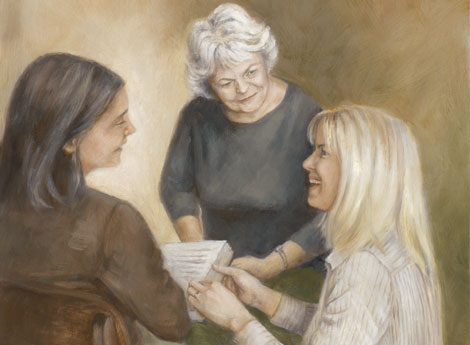
As visiting teachers share truths and bear testimony, they help others follow the Savior.
Detail from Visiting Teaching, by Shannon Gygi Christensen. © 2006 Shannon Christensen.
A young mother expressed her gratitude for visiting teachers who helped her return to gospel living:
“I’m grateful to this day for my visiting teachers because they loved me and they didn’t judge me. They really made me feel as though I really was important and that I did have a place in the Church.
“They’d come over to my home and we would sit and we’d visit … , and they would leave me a message each month.
“And when they came every month, it made me feel as if I really did matter and as though they really did care about me and as though they really loved me and appreciated me.
“Through their visiting and coming to see us, I decided that it was time for me to go back to church. I guess I just really didn’t know how to come back, and by their coming and reaching out to me, they provided a way that I could return.
“We need to realize that the Lord loves us no matter who we are, and my visiting teachers helped me see that this was right.
“Now my husband and I have been sealed in the temple.”26
Visiting teaching is a way to bring the gospel of Jesus Christ into the lives of sisters and their families. Sister Mary Ellen Smoot, the thirteenth Relief Society general president, declared: “My desire is to plead with our sisters to stop worrying about a phone call or a quarterly or monthly visit, and whether that will do, and concentrate instead on nurturing tender souls. Our responsibility is to see that the gospel flame continues to burn brightly. Our charge is to find the lost sheep and help them feel our Savior’s love.”27
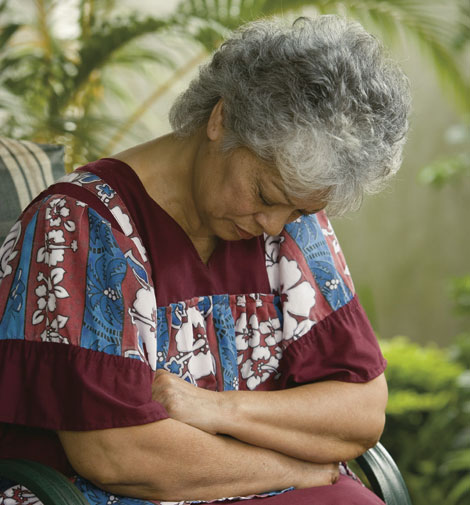
Visiting teachers can receive guidance from the Holy Ghost as they pray for help.
President Kimball taught:
“There are many sisters who are living in rags—spiritual rags. They are entitled to gorgeous robes, spiritual robes. … It is your privilege to go into homes and exchange robes for rags. …
“… You are going to save souls, and who can tell but that many of the fine active people in the Church today are active because you were in their homes and gave them a new outlook, a new vision. You pulled back the curtain. You extended their horizons. …
“You see, you are not only saving these sisters, but perhaps also their husbands and their homes.”28
Giving Temporal Help with Love
Charity is at the root of the temporal service and watchcare given by visiting teachers. Often a sister and her family members have physical needs that are difficult or impossible for them to handle alone. This might happen when a baby is born or when illness or death comes to a family member. Like the early Relief Society sisters in Nauvoo and on the trek west to the Salt Lake Valley, modern-day visiting teachers are often the first ones to help. Sister Silvia H. Allred, a counselor in the Relief Society general presidency, said:
“I marvel as I witness the countless acts of charity performed daily by visiting teachers all over the world who selflessly minister to the needs of individual sisters and their families. To these faithful visiting teachers, I say, ‘Through those small acts of charity, you follow the Savior and you act as instruments in His hands as you help, care, lift, comfort, listen, encourage, nurture, teach, and strengthen the sisters under your care.’ Let me share [two] brief examples of such ministry.
“Rosa suffers from debilitating diabetes and other ailments. She joined the Church a few years ago. She is a single mother with an adolescent son. She frequently has to be hospitalized for a few days at a time. Her kind visiting teachers not only take her to the hospital, but they visit and comfort her at the hospital while also watching over her son at home and school. Her visiting teachers serve as her friends and family.
“After the first few visits to a particular sister, Kathy discovered that this sister didn’t know how to read but wanted to learn. Kathy offered to help her even though she knew it would take time, patience, and constancy.”29
Mourning with Those Who Mourn, Comforting, and Helping to Bear Burdens
“[We are] to feed the hungry, to clothe the naked, to provide for the widow, to dry up the tear of the orphan, to comfort the afflicted, whether in this church, or in any other, or in no church at all, wherever [we find] them.”
Joseph Smith
Teachings of Presidents of the Church: Joseph Smith (2007), 426
Sister Elaine L. Jack, the twelfth Relief Society general president, taught: “In visiting teaching we reach out to each other. Hands often speak as voices can’t. A warm embrace conveys volumes. A laugh together unites us. A moment of sharing refreshes our souls. We cannot always lift the burden of one who is troubled, but we can lift her so she can bear it well.”30
A sister who had recently been widowed was grateful for visiting teachers who mourned with her and comforted her. She wrote: “I was in desperate need of someone to whom I could reach out; someone who would listen to me. … And they listened. They comforted me. They wept with me. And they hugged me … [and] helped me out of the deep despair and depression of those first months of loneliness.”31
Another woman summed up her feelings when she was the recipient of true charity from a visiting teacher: “I knew that I was more than just a number on the record books for her to visit. I knew that she cared about me.”32

Dedicated visiting teachers practice “pure religion” (James 1:27).
How Visiting Teaching Blesses the Visiting Teacher
When sisters serve others as visiting teachers, they receive blessings themselves. Sister Barbara W. Winder, the eleventh Relief Society general president, taught: “It is vital that each sister have visiting teachers—to convey a sense that she is needed, that someone loves and thinks about her. But equally important is the way the visiting teacher is able to grow in charity. By assigning our women to do visiting teaching, we give them the opportunity to develop the pure love of Christ, which can be the greatest blessing of their lives.”33
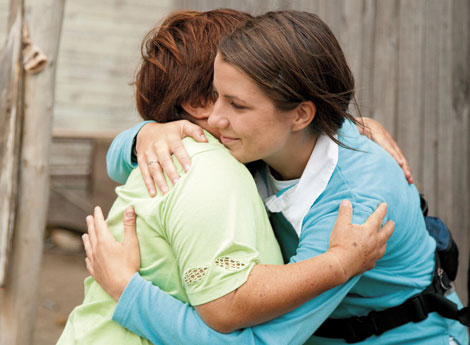
Through visiting teaching, Relief Society sisters know they have friends who care about them.
One sister told of blessings that were poured upon her as she served her sisters:
“Shortly after we were married, my husband and I moved to New Jersey. As a first-year medical student, my husband rarely returned home before 11:30 p.m. … I hadn’t made friends quickly. This move had been lonely and difficult for me.
“The bishop of my new ward asked me to head up a program for our ward’s Spanish-speaking members. This meant translating in sacrament meeting, teaching the gospel doctrine class, and overseeing the Relief Society. Outside of the native Spanish speakers, I was the only woman in the ward who spoke Spanish fluently.
“To add to my responsibilities, the Relief Society president gave me a visiting teaching list of 12 sisters who lived in a barrio across town. I’ll admit I was not thrilled about my new assignment. I was busy with my other callings, and I was afraid that I wouldn’t know how to reach out. … But I made some visiting teaching appointments, and before I knew it I was sitting in the Dumez’s living room.
“‘You’re my visiting teacher?’ Sister Dumez asked as she entered the room. ‘Welcome to my home. I haven’t had a visiting teacher in two years.’ She listened intently to the message, we visited, and she thanked me again and again for coming.
“Before I left she called her five children together to sing ‘I Am a Child of God’ in Spanish. She hugged me and squeezed my hand. …
“All of the visits during that first outing went better than I had anticipated. Throughout the following months, as the sisters graciously welcomed me into their homes, I began to look forward to my visits. But I was unprepared for the stories of tragedy and adversity I heard as I got to know these beautiful people better. I decided to at least try to make life more comfortable for these sisters and their families, many of whom struggled financially. I began taking casseroles when I visited. I took the families on outings. I drove them to doctor appointments and grocery stores.

Through visiting teaching, Relief Society sisters can find joy in serving one another.
“I quickly forgot about my own loneliness as I served others. The sisters whom I had at first considered so different from myself soon became my dear friends. They were loyal, steadfast friends who were grateful for even the slightest thing I did for them. And they anticipated my needs: I regularly received calls and gifts from the heart. One sister crocheted a doily for my table. Another composed a poem for my birthday.
“Yet, after several months in my callings, I was frustrated at my inability to make life safer or more comfortable for my friends. …
“One night I felt especially discouraged. I knelt to pray, pleading with the Lord to show me the direction to take. I felt impressed that the Lord wanted me to help these sisters become more self-reliant and serve each other. I’ll admit that I was skeptical that persons carrying such tremendous burdens would have the strength required to lift one another, but I knew I needed to follow the prompting.
“I began by reorganizing the visiting teaching program in the Spanish-speaking Relief Society. One of my faithful friends, Sister Moreira, volunteered to visit six of the sisters by herself. My first response was to protest, ‘You can’t possibly handle that route without a car. It’s too far to walk!’ But then I remembered my impression to let the sisters serve each other. I put all six sisters on Sister Moreira’s new visiting teaching list.
“Upon returning from her marathon visiting teaching course, Sister Moreira called me, filled with the Spirit. … Her feet were sore, but the Lord had lightened her load and her heart.

“When ye are in the service of your fellow beings ye are only in the service of your God” (Mosiah 2:17).
Painting by Keith Larson. © 1992 Keith Larson.
“After a few more visits, Sister Moreira recruited another sister to walk the route with her. …
“Once I started looking, I found all sorts of ways to help these sisters help themselves and each other. …
“Just at the time when I could see great spiritual growth developing among the members of my ward, I received notice that my husband and I would be moving. … I didn’t even want to think about leaving my wonderful friends. I yearned to continue serving with them—we had given each other so much. But at least I could see that the cause of the gospel was moving forth mightily in their lives, and they were looking out for one another. I, who had set out grudgingly to labor in the fields, had returned laden with sheaves.”34
Lorenzo Snow
Detail from Lorenzo Snow, by Lewis A. Ramsey. Courtesy Church History Museum.
President Lorenzo Snow, the fifth President of the Church, taught that Relief Society sisters exemplify pure religion. He said: “The Apostle James said that ‘pure religion and undefiled before God … is this: To visit the fatherless and widows in their affliction, and to keep himself unspotted from the world.’ Accepting that as true, the members of the Relief Society have most surely exemplified in their lives pure and undefiled religion; for they have ministered to those in affliction, they have thrown their arms of love around the fatherless and the widows, and they have kept themselves unspotted from the world. I can testify that there are no purer and more God-fearing women in the world than are to be found within the ranks of the Relief Society.”35
Pure and God-fearing sisters in the ranks of Relief Society have watched over and strengthened one another from the beginning days in Nauvoo to the present day, through loving and inspired visiting teaching. It is a ministry that is shared one by one, heart to heart.